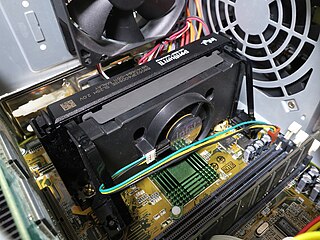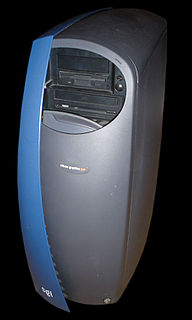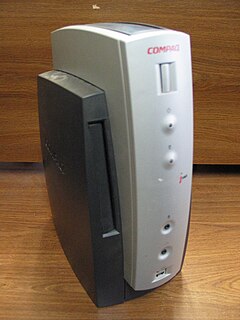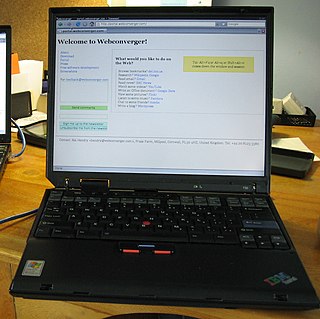Related Research Articles

In computing, PC Card is a configuration for computer parallel communication peripheral interface, designed for laptop computers. Originally introduced as PCMCIA, the PC Card standard as well as its successors like CardBus were defined and developed by the Personal Computer Memory Card International Association (PCMCIA).

Celeron is Intel's brand name for low-end IA-32 and x86-64 computer microprocessor models targeted at low-cost personal computers.

Pentium 4 is a series of single-core CPUs for desktops, laptops and entry-level servers manufactured by Intel. The processors were shipped from November 20, 2000 until August 8, 2008. The production of Netburst processors was active from 2000 until May 21, 2010.

Xeon is a brand of x86 microprocessors designed, manufactured, and marketed by Intel, targeted at the non-consumer workstation, server, and embedded system markets. It was introduced in June 1998. Xeon processors are based on the same architecture as regular desktop-grade CPUs, but have advanced features such as support for ECC memory, higher core counts, more PCI Express lanes, support for larger amounts of RAM, larger cache memory and extra provision for enterprise-grade reliability, availability and serviceability (RAS) features responsible for handling hardware exceptions through the Machine Check Architecture. They are often capable of safely continuing execution where a normal processor cannot due to these extra RAS features, depending on the type and severity of the machine-check exception (MCE). Some also support multi-socket systems with two, four, or eight sockets through use of the Quick Path Interconnect (QPI) bus.

Slot 1 refers to the physical and electrical specification for the connector used by some of Intel's microprocessors, including the Pentium Pro, Celeron, Pentium II and the Pentium III. Both single and dual processor configurations were implemented.

SGI Visual Workstation is a series of workstation computers that are designed and manufactured by SGI. Unlike its other product lines, which used the 64-bit MIPS RISC architecture, the line used Intel Pentium II and III processors and shipped with Windows NT 4.0 or Windows 2000 as its operating system in lieu of IRIX. However, the Visual Workstation 320 and 540 models deviated from the architecture of IBM-compatible PCs by using SGI's ARCS firmware instead of a traditional BIOS, internal components adapted from its MIPS-based products, and other proprietary components that made them incompatible with internal hardware designed for standard PCs and hence unable to run other versions of Microsoft Windows, especially Windows 9x. By contrast, the remaining models in the line are standard PCs, using VIA Technologies chipsets, Nvidia video cards, and standard components.
The Sony U series of subnotebook computers refers to two series of Sony products the PCG-U and the VGN-U. The later VGN-U were, at their release, the smallest independent computers running Windows XP and the most powerful high-end subnotebooks at the time. The VGN-U50 and VGN-U70P models are roughly the size of two DVD cases stacked on top of each other.

Toughbook is a line of rugged computers produced and marketed by Panasonic Corporation. The Toughbook, introduced in 1996 with the CF-25, is, like most other rugged laptops, designed to withstand outside forces which would normally damage or destroy normal laptops. Toughbook mobile computers are used in a wide variety of industries, including construction, defense, emergency services, government, healthcare, law enforcement, manufacturing, oil, gas, telecom, and utilities.
The Intel Core microarchitecture is a multi-core processor microarchitecture unveiled by Intel in Q1 2006. It is based on the Yonah processor design and can be considered an iteration of the P6 microarchitecture introduced in 1995 with Pentium Pro. High power consumption and heat intensity, the resulting inability to effectively increase clock rate, and other shortcomings such as an inefficient pipeline were the primary reasons why Intel abandoned the NetBurst microarchitecture and switched to a different architectural design, delivering high efficiency through a small pipeline rather than high clock rates. The Core microarchitecture initially did not reach the clock rates of the NetBurst microarchitecture, even after moving to 45 nm lithography. However after many generations of successor microarchitectures which used Core as their basis, Intel managed to eventually surpass the clock rates of Netburst with the Devil's Canyon microarchitecture reaching a base frequency of 4 GHz and a maximum tested frequency of 4.4 GHz using 22 nm lithography.

The iPAQ Desktop Personal Computer in its various incarnations was a legacy-free PC produced by the Compaq Computer Corporation around the year 2000.

The Intel 440BX is a chipset from Intel, supporting Pentium II, Pentium III, and Celeron processors. It is also known as the i440BX and was released in April 1998. The official part number is 82443BX.
Since the rise of the personal computer in the 1980s, IBM and other vendors have created PC-based IBM-compatible mainframes which are compatible with the larger IBM mainframe computers. For a period of time PC-based mainframe-compatible systems had a lower price and did not require as much electricity or floor space. However, they sacrificed performance and were not as dependable as mainframe-class hardware. These products have been popular with mainframe developers, in education and training settings, for very small companies with non-critical processing, and in certain disaster relief roles.

The Samsung Q1 was a family of Ultra-Mobile PCs produced by Samsung with a 7" (18 cm) LCD and exists in several different versions with either Windows XP Tablet PC Edition or Windows Vista Home Premium

Mac Pro is a series of workstations and servers for professionals that are designed, developed and marketed by Apple Inc. since 2006. The Mac Pro, by some performance benchmarks, is the most powerful computer that Apple offers. It is one of three desktop computers in the current Macintosh lineup, sitting above the consumer Mac Mini and iMac.

The Compaq Presario 1200 was a line of notebook computers produced between 1998 and 2000 by Compaq as part of Compaq Presario line. They were originally noted for their AMD processors, light weight and 12-inch LCD screens, while later models included a shift to Intel processors and other changed features. The label of "Compaq Presario 1200" includes a vast set of model numbers and revisions, many of which are not totally compatible, even though the machines share the same general Presario model number.

The WebPC was a short-lived personal computer designed by Dell Computer for the consumer market. The computer was designed to make it easy for home users to connect to the Internet. A small form factor machine, the WebPC was an early system in a class known as legacy-free PCs.
The ICL DRS was a range of departmental computers from International Computers Limited (ICL). Standing originally for Distributed Resource System, the full name was later dropped in favour of the abbreviation.

IBM ThinkPad 760 was a notebook computer introduced in 1995 by the IBM corporation into the market as part of the ThinkPad 700-series. It was succeeded in 1998 by the ThinkPad 770 series.
The A Series desktops are part of Lenovo’s ThinkCentre product line. Formerly an IBM brand, Lenovo acquired the ThinkCentre desktop brand following its purchase of IBM’s Personal Computing Division (PCD) in 2005. The first desktop in the A Series was the ThinkCentre A50p. Lenovo has released A Series desktops in multiple form factors, ranging from traditional tower, to small form factor, and all-in-ones (AIOs).

The IBM ThinkPad T30 is a laptop computer manufactured by IBM.